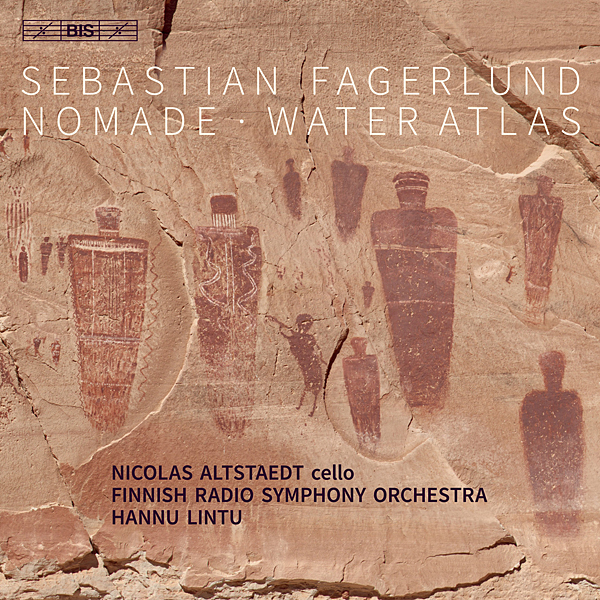| Columns Retired Columns & Blogs |
I also liked the Fagerlund pieces, especially the cello concerto. And if you haven't heard it, I'd suggest checking out the Pentatone recording of orchestral works by Coll, especially the violin concerto.

These three symphonies, all dating from the first half of the 20th century, comprise so apt a program that I'm surprised no one did it before. The striking contrasts among them—Barber's First unusually angular (for him), Sibelius's Seventh rugged and forward-looking, the Poem of Ecstasy (Scriabin's Fourth) mystical and impulsive—serve to underline their common features. Who knew, for example, that Barber could sound startlingly like Sibelius?
The program demands front-line virtuoso playing, and the Kansas City Symphony proves up to the challenge. The string sections sound well-blended and beguilingly warm. The suave woodwind soloists form a velvety choir, capable of fetching light staccatos. Brasses are a firm and round presence, without overbalancing. The ensemble sonority is full-throated and varied (though quieter dynamics in the Barber don't correspondingly lighten the textures, which stay rather full).
Michael Stern does a fine job, shaping phrases with purpose, leaning into important accents (including Scriabin's whooping horns!), surging into climaxes. He projects undulating rhythms in the Sibelius, with a fine sense of all the counterpoint. The Scriabin is clear and impressive, though the background phrases that propel the trumpet theme aren't always sufficiently present. You can't hear the structure Barber outlined in the notes—you never can—but the sequence of episodes feels compelling, even if everyone's just catching some of the rhythmic intricacies.
Prof. Johnson and Reference Recordings provide bright, transparent, balanced sonics that suggest we're hearing the orchestra unmediated. Bravi tutti.—Stephen Francis Vasta

Sebastian Fagerlund: Nomade • Water Atlas
Nicolas Altstaedt, cello; Finnish Radio Symphony Orchestra, Hannu Lintu, cond.
BIS-2445 (auditioned in 24/96 FLAC). 2021. Laura Heikinheimo, others, prods.; Enno Mäemets, others, engs.
Performance ****
Sonics ****
Sebastian Fagerlund may not be a household name in the United States, but the young Finnish composer already has some impressive credits and achievements including Finland's Teosto Prize in 2011 and composer-in-residence at the Amsterdam Concertgebouw. More important than accolades or prizes is his expansive music, which defies categorization, transitioning from lyrical serenity to intense explosions and thrilling percussion.
Together, these two compositions seem to reflect the rugged islands of Finland's archipelago, which Fagerlund views often during summers by the Baltic Sea. I say "seem" because you cannot easily grab hold of Fagerlund's music. It's not like the music of Beethoven and Brahms, which abounds in naked expression, recognizable melodies, and lines you can identify and follow. Fagerlund's music is characterized by unexpected surges of energy, remarkable textures, and unpredictable moods and feelings. At its best, it awakens a sense of mystical wonder at the workings of nature in its most raw and elemental state.
Nomade (2018) is dedicated to German-French cellist Nicolas Altstaedt, who on this recording draws an astounding range of sounds from his instrument. Sections of Nomade's contemplative and haunting lento movement offer opportunities for Altstaedt's instrument to whine and whisper. After much agitation, Nomade simply fades away.
Water Atlas unfolds in a single movement, like a Strauss tone poem, complete with huge climax. This is fascinating stuff, well worth exploring.—Jason Victor Serinus

Andrew Von Oeyen: Bach • Beethoven
Andrew von Oeyen (piano)
Warner Classics 0190295020514 (CD). 2021. Michael Fine, prod.; Erdo Groot, eng.
Performance ****½
Sonics *****
When pandemic closures halted concert life, Andrew von Oeyen found his standard repertoire unequal to the moment's uncertainty. But Bach's music spoke to him uniquely and universally, providing order amid the chaos.
The French Suite, recorded last September, is magnificently played, with limpid tone, impeccable articulation, and beautiful trills. The soloist draws a full expressive range from the suite's eight movements. The stately Ouverture contrasts nicely with the following Courante, grounded and not too "runny," and the perky Gavottes. The sparkling flourishes of the two Passepieds, with added graces on the repeat, set off a gentle, meditative Sarabande.
Turning to Beethoven, von Oeyen sounds uncommitted in the soft-edged in-between chords at the start of the E-flat sonata. The second group of chords brings more gravitas and weight. The volatile outbursts are full-bodied, as is the violent, minor-key Scherzo. The soloist makes a good stab at chordal phrasing in the Adagio (though the scansion's not immediately clear) and provides quick, explosive contrasts in the finale. The Appassionata allows von Oeyen more scope, though the poised, gracious opening movement, despite aggressive fortes, feels restrained. Crisp articulations again make the day, as they do in the variations of the Andante con moto. The finale's runs are dazzling.
Of Wilhelm Kempff's Bach arrangements, I preferred the simpler Siciliana, but on both, von Oeyen's translucent chordal voicings are awe-inspiring.
Warner's engineering here is clean and well-defined to match the crisp playing, with just a few moments of clangor in the Appassionata's first movement.—Stephen Francis Vasta

I also liked the Fagerlund pieces, especially the cello concerto. And if you haven't heard it, I'd suggest checking out the Pentatone recording of orchestral works by Coll, especially the violin concerto.

I'm supposed to review Seattle Symphony's US premiere of the Coll Violin Concerto with Patricia Kopatchinskaya, and have been thinking about listening to the recording and reviewing it if I like it. Alas, PK may not be able to secure a visa and the performance may be put on hold. Time shall tell. Meanwhile, thank you so much. And...
I also want to listen to the new Vasks recording that includes a Cello Concerto. So many new recordings, so little time....

Hopefully, despite being unmentioned, some of these recordings are SACDs (as BIS and Pentatone discs usually are), but why is this not declared as this is essential information for most collectors?

Duly noted. When I leave this information out, it's because I request files rather than physical product. Which doesn't mean that I can't include it in the future.
Please note that BIS records in 24/96, not DSD; it converts to DSD when it manufactures its SACDs. Similarly, I believe that Keith Johnson records in 24/192.

Leaving aside pieces - definitely and certainly written by him FOR a piano-forte - of which there aren't a whole lot
You will be playing an arrangement that leaves lots of notes out, or leaving them out yourself.
Especially if the piece was written for a two-manual harpsichord, which most of them were.
This just isn't arguable.
I began singing in an Anglican (Episcopalian) cathedral in 1960 at age ~ 9 yrs, in the firsts and was made a 'leader' @ 11 yrs .
Our Choirmaster / Organist spent a lengthy sabbatical at Kings and St Johns in the UK, when HIP began to really take off. ? Early 1960s.
Musical expression is embedded in attacks and decays, not in harmonics or in vibrato.
IME -
with choirs as a HIGH-CHURCH Anglican boy-soprano and Leader (under RSCM rules,) in choirs and listening to them in the audience, ......
vibrato is used by female sopranos.......
To try - mostly unsuccessfully - to hide the reality that they can no longer reach or hold certain high notes.
Fidelity just does, start, well before the recording process and the home-audio gear we own.
Lord save me - from age-ing female sopranos - aka 'wobblers'!
LBNL good sound at home is possible without $$$$$$ gear. It does require careful, thoughtful set-up of spkrs (and listeners) in the room they are in.
Timbo in Oz